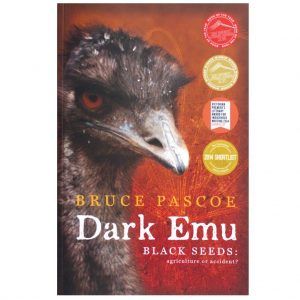I went to see Bangarra Dance Theatre‘s production of Bruce Pascoe‘s non-fiction book Dark Emu tonight at the Sydnery Opera House, fittingly, during NAIDOC Week.
Dark Emu is amazing. I am not good at talking about dance—it’s not my language—but this was mesmerising. There were 15 dancers, and the staging was stunning. Turning a non-fiction book like Dark Emu into dance performance must have had very specific challenges, but they captured so much of the book, both the content and the significance, and the emotion of coming face to face with the rich truth of Aboriginal history and culture.
Before the performance started I noticed Uncle Bruce Pascoe take a seat a couple of rows in front of me, and then I realised an old mate and colleague, Cathy Craigie, was sitting with him. Turns out we picked a good night to go — Cathy moderated a discussion between Uncle Bruce and Stephen Page from Bangarra Dance Theatre. What luck!
There were various scenes which, in boldly and sinuously choreographed moves and utterly stunning costumes, portrayed Aboriginal agricultural and aquicultural practices. Impressionistic scenes of seed harvesting, fishing traps (the world’s first feat of engineering), whale hunting. Exquisite scenery constructions of a burning banksia seed, seed-gathering basket, a canoe; lights evoking the Dark Emu of the title (the space around the Milky Way), a scene depicting the building of stone houses (later described by Cathy and Bruce: “We built the first village—we invented society”), and a penultimate scene reminding us of the confinement of people and culture and the loss of knowledge, as the dancers stood and moved along and around a long rope, an image I won’t forget in a hurry.
The audience response was both deeply felt and wildly enthusiastic. If you can go and see it, go and see it.
And did I mention the score? It was incredible. I hope they release it. It was gorgeous, a blend of traditional Aboriginal song and instruments and rhythms with western wind instruments, piano, strings, singing and spoken word.
And then we stayed for the discussion afterwards, as did most of the audience: Stephen mentioned that Bangarra is the only major Aboriginal arts company to receive OzCo funding on an on-going basis (next year is its 30th anniversary), and the only company that can fill a 6 week season in the Drama Theatre at the Opera House to 90% capacity.
Talking about the work Bangarra does, Stephen connected it straight back to cultural practice, saying, These are our modern rituals. He also talked about how they always take their performances back to Country, and how even if there are only 14 people to perform to, then those 14 are elders, holders of story, and that is enough.
Cathy and Bruce talked about how the performance has changed from opening night; this is such a layered and complex performance, I am sure part of that is that they saw different things each time, but it’s also true that it is a living thing, this dance, and it not only bears repeat viewings (I would see it again in a heartbeat if I had the time and money), but also it is changing from performance to performance.
Bruce spoke quite a bit about how the book came about, and the importance of Australia knowing its true history. Otherwise, he said, all we’ve got is Don Bradman and failed military campaigns and the stump-jump plough—and we don’t have any stumps left.
Cathy observed that she has seen a shift in the national conversation in the past five years, that there’s a growing interest in and appreciation of Aboriginal history and culture, and she asked why that might be. Bruce’s take on that was that young people are deeply invested in this land, and in protecting it, because god knows we’re in desperate times, environmentally, and they are looking to Aboriginal ways of custodianship to learn from. “They want to know how to love this land.”
Which echoed straight back to the last words of the musical score to the performance:
Thank you, my Country.
Thank you, my Country.
Thank you, My Country.







